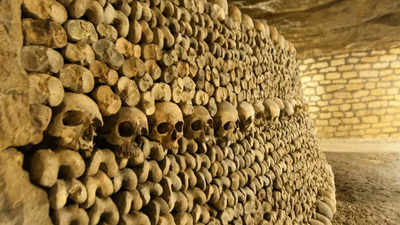Trending
What! This tunnel contains the bones of 6 million people
Beneath Paris lies the mysterious Catacombs, a silent labyrinth housing the remains of over six million people. Originating from a public health crisis in the late 18th century, these repurposed limestone quarries became the solution to the city's overflowing cemeteries. Bones were ceremonially transferred and arranged along the catacombs' walls, drawing fascination and curiosity over time. Now a popular tourist attraction, they offer a unique glimpse into Paris's past, extending across a vast network beneath the bustling streets.

The catacombs of Paris are home to 6 million bones and provide an eerie sight to visitors upon entry. Source: Canva
Beneath the bustling streets of Paris lies a dark and silent labyrinth, the final resting place of millions. The Paris Catacombs, a network of old quarry tunnels, have become one of the most enigmatic burial grounds in the world. This subterranean ossuary holds the remains of over six million people, adding a macabre aspect to the city’s history.
The origins of the catacombs date back to the late 18th century, a time when Paris faced a critical public health crisis.The city’s cemeteries were overflowing, with the oldest, the Saints-Innocents cemetery, becoming a source of infection for the local inhabitants. After a series of basement wall collapses in 1774, it became clear that a solution was needed.

The solution was radical and came from the depths beneath the city. The long-abandoned limestone quarries, which had provided the stone for many of Paris’s finest buildings, were repurposed into an ossuary. In 1786, the Council of State authorized the removal of all human remains from the city’s cemeteries and their transfer to the underground tunnels.
The catacombs were consecrated as the “Paris Municipal Ossuary” on April 7, 1786, and took on the name “Catacombs” in reference to the ancient Roman
In the early 19th century, the catacombs began to attract visitors, becoming a novelty place for concerts and private events. After further renovations and the construction of access points, they were officially opened to the public in 1874. Today, they are managed by Paris Musées and remain a popular tourist attraction, offering a unique glimpse into the city’s past.
The catacombs extend south from the Barrière d’Enfer, a former city gate, and span a vast network that is only partially accessible to the public. The ossuary comprises only a small section of the underground mines of Paris, yet it is often referred to as the catacombs in its entirety.
The origins of the catacombs date back to the late 18th century, a time when Paris faced a critical public health crisis.The city’s cemeteries were overflowing, with the oldest, the Saints-Innocents cemetery, becoming a source of infection for the local inhabitants. After a series of basement wall collapses in 1774, it became clear that a solution was needed.

The Paris catacombs came up as a result of a critical public health crisis in the 18th century. Source: Canva
The solution was radical and came from the depths beneath the city. The long-abandoned limestone quarries, which had provided the stone for many of Paris’s finest buildings, were repurposed into an ossuary. In 1786, the Council of State authorized the removal of all human remains from the city’s cemeteries and their transfer to the underground tunnels.
The process of transferring the bones was both secretive and ceremonial. At night, covered wagons transported the remains from the cemeteries to a mine shaft opened near the Rue de la Tombe-Issoire. The bones were then arranged in the catacombs’ walls, creating walls of femurs and skulls that line the corridors.
The catacombs were consecrated as the “Paris Municipal Ossuary” on April 7, 1786, and took on the name “Catacombs” in reference to the ancient Roman
catacombs, which had fascinated the public since their discovery. Initially, the catacombs were a practical solution to a pressing problem, but over time, they became a subject of fascination and curiosity.
In the early 19th century, the catacombs began to attract visitors, becoming a novelty place for concerts and private events. After further renovations and the construction of access points, they were officially opened to the public in 1874. Today, they are managed by Paris Musées and remain a popular tourist attraction, offering a unique glimpse into the city’s past.
The catacombs extend south from the Barrière d’Enfer, a former city gate, and span a vast network that is only partially accessible to the public. The ossuary comprises only a small section of the underground mines of Paris, yet it is often referred to as the catacombs in its entirety.
End of Article
FOLLOW US ON SOCIAL MEDIA









